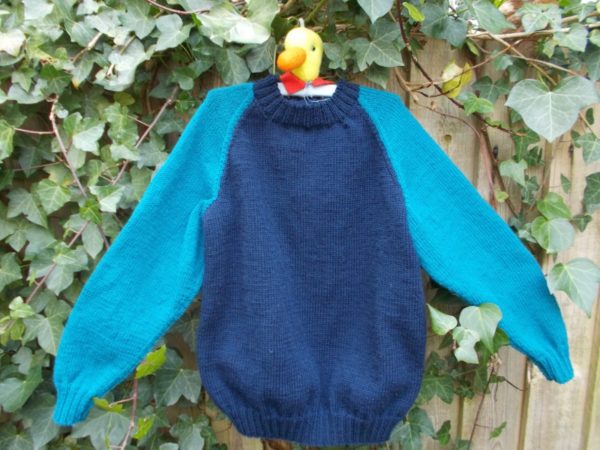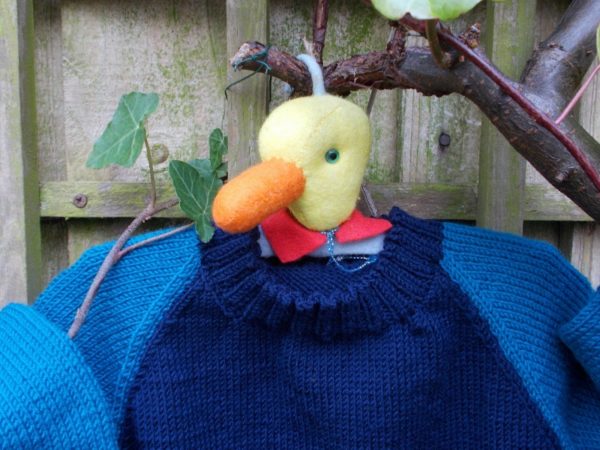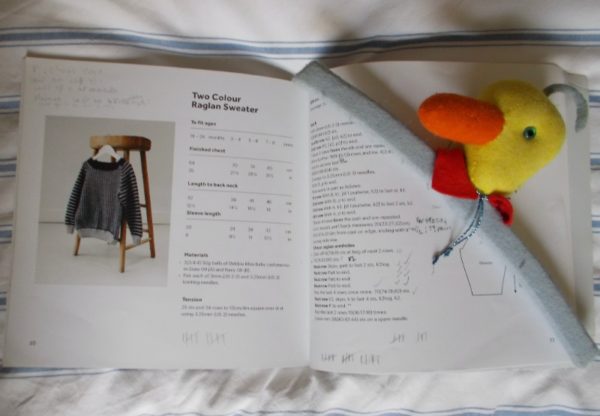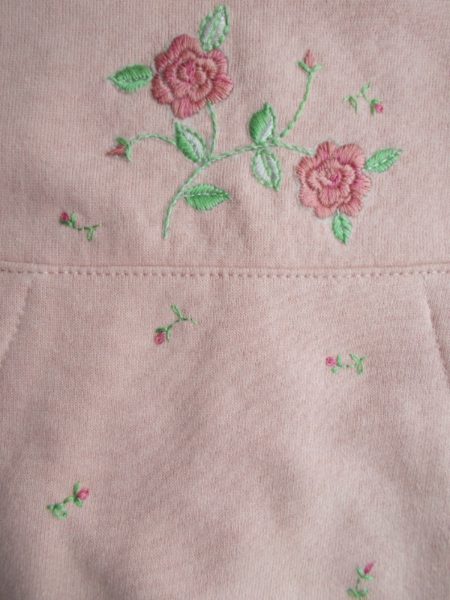
Roses on a sweatshirt for little girl aged 4 (hand embroidered by Mary Addison)
My grandchildren should receive their Christmas presents from us tomorrow – not quite a month after Christmas! (That’s the sweater in the last post plus this hoodie.) The children should wear them straightaway, and wear them lots, as not having measured them for 6 months, I’ve had to make judgments about how much they’ve grown in that time and it’s so easy to get this wrong!
Storm Christophe has caused lots of flooding across the UK generally and in lower lying areas of our own county, Gloucestershire, in particular. We have been fortunate to have missed the really heavy rain and somewhat miraculously both yesterday and today have even been sunny and pleasant. In fact the last couple of days have been the epitome of good drying weather, so what could I do but gather up bulky items like towels and bedlinen and push them into the washing machine ready for a spell of line drying. There’s nothing like well blown household linen as you take it off the line, dry but not stiff and smelling of the outdoors, rather than crumpled from a few hours spent on a downstairs’ radiator and smelling ever so slightly of the fish you had for dinner.

Roses on a sweatshirt for little girl aged 4 (hand embroidered by Mary Addison)
It’s odd that even in the 21st century household clothes drying should still be such a problem. Utility rooms are an excellent idea but few of us can afford a house of the size to merit one. Some friends have converted basements to rough approximations of one but these are often approached by rickety staircases, have low ceilings and are not exactly spacious. Others in old houses have former sculleries for washing machines and dog baskets but these always seem to feel a bit too cold and damp already before you even think of adding wet washing. My daughter has made use of the area under the steps up to the front door for the washing machine but drying has to be done elsewhere. In the UK larger houses built on new estates may include utility rooms but the smaller houses on the bulk of these estates are really quite small and counter intuitively can be built to lower specifications than those for social housing! Before we married and after he had retired from being a priest in charge of a parish and the vicarage that came with it, my husband lived in a tiny house on a new estate in Monmouth. Ostensibly 3 bedroomed, only one bedroom was big enough to have a wardrobe and in none of them could you have a standard double bed with access to both sides of the bed! The kitchen was more generously sized but at the expense of the living room in which only the smallest of sofas would fit. (A nearby neighbour, in a slightly bigger house, would do her ironing in the garage – in her underwear and with the garage door open – a bit disconcerting for a retired vicar! )
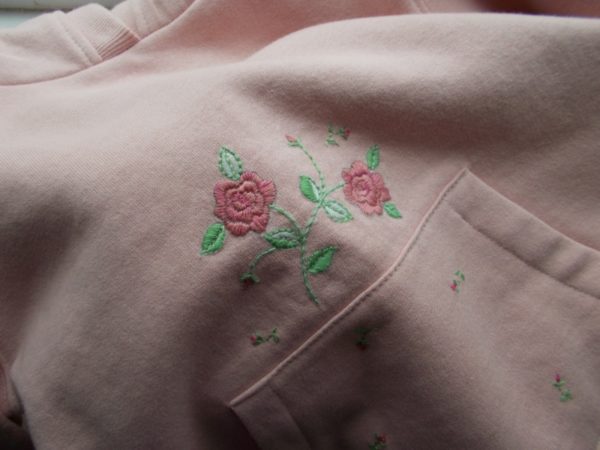
Roses on a sweatshirt for little girl aged 4 (hand embroidered by Mary Addison)
When I lived in a 6 bedroomed house in Chiswick, if I couldn’t use the washing line in the garden, the drying problem was solved by bedecking my great beast of a four oven Aga and a good long kitchen radiator with swathes of wet household linen and clothing, which it has to be said dried in no time at all. Nearby was a proper airing cupboard with a boiler and shelves above – things dried were folded up and aired in the airing cupboard and then, theoretically once every day, the cupboard could be emptied and things distributed to peoples’s rooms. It was quite time consuming with 3 adults and 4 children and for it to work you had to keep the up the rhythm of items moving from one place to the next or logjams would occur and the production line would foul up. Our Aga had a particularly long towel rail just right for drying (and basically ironing) a super king duvet cover – bliss! Adding lodgers to the mix was interesting. One lodger was very partial to wearing thongs and I have it in mind that I once dried 70 thongs in one go – the Aga looking more like an Indian elephant decked out in all its finery than a stalwart domestic appliance. (I think I must be exaggerating – surely no one person has anything like 70 pairs of knickers.) At the other end of the scale, one of our Japanese students, a middle aged woman studying English at a nearby college, liked those items of underwear called bodies – or even worse teddies – and I could only dry 3 of these at the time, the hobs being too hot for the lycra fabric. Of course, if you had people round, washing schedules were very carefully choreographed or postponed.
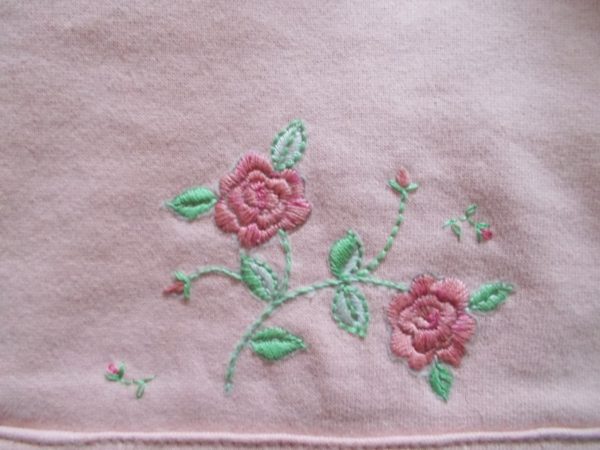
Roses on a sweatshirt for little girl aged 4 (hand embroidered by Mary Addison)
Then I think back to my childhood and remember the washing, let alone the drying being such a labour. When I was very little I have clear memories of my mother boiling sheets, towels and whites in a coal fired copper in the back garden on a Monday morning. It would put her in a very bad mood (and I don’t blame her). As the mangle removed very little water from wet things, you were completely reliant on a good breeze to get things dry enough to bring into the house. Advent of the single tub washing machine, with pop up mangle, still left you with the drying problem, so it was only some time after 1962 when the Servis Twin Tub machine appeared in our kitchen that our lives noticeably changed. A splendid giant in white enamel with pale blue Art Deco control panel it looked like a space age machine worthy of the children’s Science Fiction puppet TV programme Fireball XL 5 (also 1962 the invention of Gerry Anderson who went on to greater fame with Thunderbirds). The tumble drier spun at a mighty 2,000 rpm (most machines today spin at 1,200 rpms many think higher rpms make little difference) which meant less time needed for sheets on the line. As I think by this time we also had central heating, wash day miseries soon became past memories. I think we still stuck to Mondays for washing as the machine had to be pulled out from under the kitchen worktop, a bi-forked hose hooked up to the taps for water while a waste water pipe hooked over the sink. For several reasons, mainly aesthetic, I loved this machine. My parents must have had an automatic washing machine after I went to university.
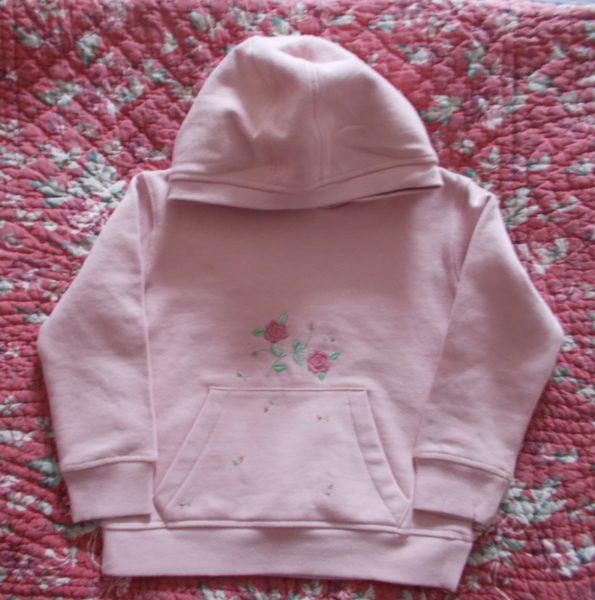
Roses on a sweatshirt for little girl aged 4 (hand embroidered by Mary Addison)
The Hoover Keymatic was the first automatic washing machine I remember. Working in Oxford after university there, I lived in a flat in a house belonging to Salter’s Boatyard just off the towpath down from Folly Bridge. One of my flat mates had academic parents living in Oxford and as they upgraded their washing machine, we got their old one which was great. A front loader – very novel to me at the time – the Hoover Keymatic was distinctive with a big swollen belly that pushed forward at angle. The key of its name took the form of a thick plastic square, very like bars of Ritter chocolate. Each side of the square produced a different washing cycle according to which way you inserted the key into the machine. So, not very automatic and in fact a bit limiting as I’m not sure you could ever just spin some hand washed clothes, for instance. The key was probably a bit of a gimmick. Like my mum’s old Servis, you still had to fix a hose to taps and loop the waste pipe over a sink. But, where the Servis just connected to the taps with a simple rubber hose, the Hoover’s came with hoses with metal straps you tightened with a screw driver once on the tap … and that is where things one day went very wrong for me. Screw heads become worn and get progressively more difficult to tighten. I pushed too hard and my hand with the screw driver shot away from the screw and up … into my eye – happening so quickly I didn’t realise what I’d done. I must have made some sort of groaning and I left the room. A flat mate was in the bathroom next to the kitchen so, hearing the noise he came out, but the afternoon radio play was on and suggesting itself as source of the racket, he returned to the bathroom. Well, at some point he and I met up and mercifully I remember little until being examined in the Oxford Eye Hospital and asked when I last ate. A general anaesthetic later I woke up to find I was the proud possessor of 14 of the neatest little black stitches across the bottom of my eyeball. There are more unglamorous things in life than black eye patches. Forty plus years later my wounded eye has served me well. The arrival of the plumbed in washing machine is I believe one of mankind’s greatest advances!
I shall, however, never call a washing machine truly automatic until it sorts, loads, washes, dries and fold clothes before returning them to their appointed storage site.

